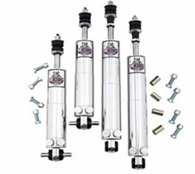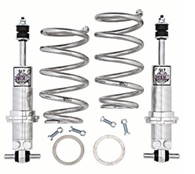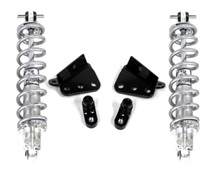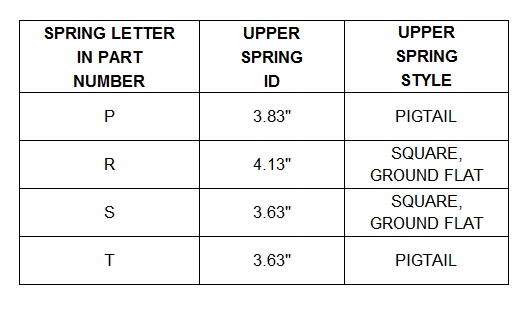|
While
we work on a more interactive website for our “Search by Vehicle”, we have
provided two application guides that can be viewed / downloaded in PDF as
follows:
Street
Focus: Utilize this guide when the desired vehicle use is mainly
for street purposes. The goal for the vehicle is to either to maximize ride comfort
for general cruising or to provide a performance feel for more spirited driving
with some possible trips to a track / event.
Competition
Focus: Utilize this guide when the desired vehicle focus is based
on a specific type of performance / competition. The goal for the vehicle could
be drag race oriented, which is further narrowed to prep or no prep, or the goal
could be a pro-touring set-up with the intention of competing in autocross,
time attack, or road course events or some sort of combination thereof.
To
assist in finding the correct solution for your vehicle:
STEP 1: Locate
the Make, Model and Year in the Appropriate Guide
If your
application is not listed in either guide, please call for assistance. We are
also constantly working to add additional applications.
STEP 2: Determine
the Desired Ride Height
The Application
Guides are divided into two categories for each application: Standard Height
and Dropped Height. In general, the standard height allows for factory to a
1.5" lowered ride height; however, a double adjustable front coil-over
shock in an A224 length or taller will usually allow for up to 2" lower
ride height. The triple adjustable eyelet bottom shocks are 0.30" taller
than the double adjustable. This shifts the shock ride height range up
1/4" to 3/8". As such, only the double adjustable can exceed the
1.5" drop on the front of vehicles for A224 length and taller. If a ride
height outside of the ranges provided in the application guides is desired (raised or lowered), then please
consult Viking to determine the proper part for the application.
NOTE: The ride height range provided is based on a shock/spring combination and not
on other means, such as drop spindles. If vehicle modifications have been made
that would alter vehicle height/stance, such as drop spindles or lower control
arms with a built-in drop, these modifications must be considered when
selecting the correct shocks. Please call us to discuss any of these issues /
changes to ensure proper part number determination. Ride
height is absolutely critical in overall ride quality and performance. We receive too
many calls where someone believes they have an improper spring rate due to a harsh
ride when, in reality, the shock is topping or bottoming out due to inadequate
travel. Please see the "Ride Height Measurements" menu for more information.
STEP 3: Consider the Primary Intended Use of the Vehicle
As discussed above, you have already selected the appropriate Application Guide for your intended use. Now you will need to determine the Viking Series, the level of adjustability and, if applicable, the optimal valving option that will meet your desired goals. While the guides will provide recommended valving options, please review "Choosing the Series", "Choosing the Adjustability" and "Choosing the Valving" menus to assist in determining the best series and valving solution that meet your specific goals.
STEP 4: Smooth Body vs. Coil-Over
  
When comparing a smooth body shock and a coil-over shock, the most obvious answer is that the coil-over allows for a spring to sit over the shock/strut on a spring nut threaded onto the shock/strut body as one unit (hence the term "coil-over"), whereas a smooth body shock/strut does not. Just a shock itself will not hold the weight of the vehicle; it is strictly there to dampen dynamic movements in the suspension. The addition of the spring allows the coil-over to be a weight bearing part of the suspension system while still damping the dynamic suspension movements with the shock portion of the coil-over. There are some definite advantages to the coil-over. First, the stance of the vehicle can be altered with a coil-over, allowing the vehicle to attain the desired look or performance. In addition, there are far more spring rate choices for a coil-over shock versus a factory style spring. This will allow for the suspension to be optimized for the intended use of the vehicle, whether it is cruising, handling on the autocross track / road course, or for drag racing. Please note that although you can alter the stance with a coil-over, there are always limits to the amount of adjustment you can make, as it is critical to remain in the recommended ride height range of the coil-over shock. Please see the "Ride Height Measurements" menu for more information)
Smooth body Shock: Choose these when you do not want or need the ability to alter the stance of your vehicle. They are available for the front and/or rear of many applications. These shocks offer bolt-in performance, and come complete with all mounting hardware.
Front Coil-Over Kit: Available for many popular applications, the coil-overs allow the user to adjust the front ride height. These kits provide an easy, bolt-in coil-over conversion. Front coil-over kits include the two front coil-over double or triple adjustable shocks or struts, two high travel springs and all mounting hardware. Caution: while the Viking shock coil-over kits will work with factory control arms, please verify that the condition and the thickness (minimum of 3/16") is satisfactory to support the weight of the vehicle. In addition, if the shock comes with a T-bar in the lower mount, it MUST be installed on top of the control arm. Failure to follow all instructions for coil-over installation may result in injury and/or death.
Rear Coil-Over Kit: Viking bolt-in rear coil-over kits are available for many applications and allow the user to adjust the rear ride height while improving ride quality and performance. These kits include rear coil-over conversion brackets (when required), two double or triple adjustable coil-over shocks, two high travel springs and all mounting hardware. It is critical to properly utilize all mounting brackets, as the factory mounting points were not designed with a coil-over option in mind in order to support the weight of the vehicle.
Coil-Over Notes:
- All coil-overs listed in this guide include bearing mounts. We recommend
bearings as they perform better in supporting the weight of the vehicle and
provide for misalignment when needed, thereby relieving unnecessary stress on
the piston rod and seals. If poly mounts are preferred, please call for proper
part numbers.
- The front and rear coil-over kits listed in the application guide do not
include spanner wrenches or thrust bearings. We highly recommend adding the
appropriate kit. Please see find these under "Add On Accessories".
STEP 5: Understanding Spring Rate Selection
The application guides provide a baseline spring rate as well as the
correct spring style for a given application based on the following assumptions:
- The vehicle weight is assumed as factory with a small block or LS engine. If you have a big block, the front coil-over spring rate will need to be adjusted accordingly. If the front coil-over kit part number ends in a "P", "R", "S", or "T", simply add 100 lbs to the rate listed in the guide (e.g. A225-450T becomes A225-550T for a big block).
- The motion ratios are at or near factory specifications.
- If the weight of the vehicle changes for any other reason (carbon fiber body parts, supercharger added, etc.), the spring rate must change accordingly.
If any of the assumptions change or you are unsure, it is ALWAYS best to give us a call to discuss your particular vehicle in detail. The spring rates will often change based on the intended use of the vehicle, so please make sure you are looking at the correct guide.
Spring Notes:
The application guides provide a baseline spring rate as well as the correct spring style for a given application based on the following assumptions:
- The spring rate affects how much the vehicle can be lowered. If a
heavier spring rate is desired for a pro-touring set-up, the heavier rate may
not allow you to lower the vehicle to the desired stance. We may have a solution for a shorter spring with heavier rate where adding a take-up spring may be necessary.
- Aluminum heads and an aluminum intake will not change the recommended
spring rates in the application guide.
- It is possible for a vehicle to be undersprung. Do not always assume
that the lightest rate spring will provide for the best ride quality. Lighter rate does not equate to a better ride. The key is to properly determine / calculate the correct spring rate.
- For vehicles utilizing a strut, the strut body has a larger diameter, which may cause the spring to rub on the body. Utilizing a taller and/or lighter rate will make this problem more likely to occur.
- More research and discussion may be necessary to ensure the optimal spring rate if you are building a purpose-built vehicle or the vehicle has been substantially altered.
- If the coil-over kit part numbers in the application guide have a
"P", "R", "S", or "T" at the end of the
part number, this letter specifies the spring style that fits into the factory
upper spring mount on the vehicle. See the spring section in this guide for
lengths and rates of the various styles shown in the table below:

|